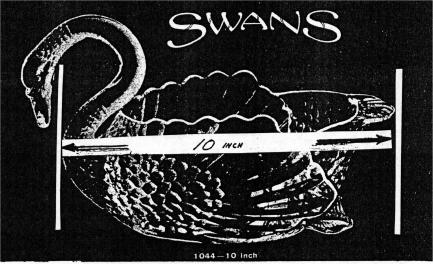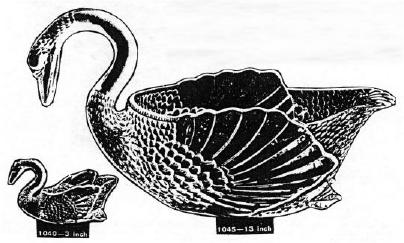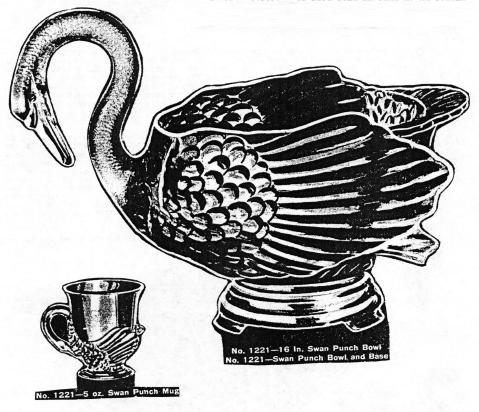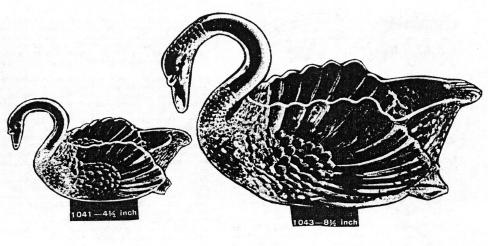Cambridge SWANS
by Frank and Vicki Wollenhaupt
Issue 36 - April 1976
"How do you measure a Cambridge Swan?" Have you ever been asked this question? In this article we will attempt to explain how to measure them - plus give you as many facts on swans as we have available.
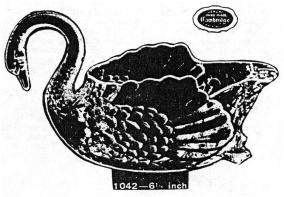 The Cambridge Swan was introduced to the trade in December, l928. An
ad in the December 17, 1928 issue of China, Glass and Lamps,
states that the useful and decorative Swans were available in
transparent colors, but does not mention available sizes. A photo taken
of the Cambridge Glass Company's display at the Ceramic Exposition in
March, 1929, shows Swans in five sizes: 3 in., 4½ in., 6½
in., 8½ in. and 10 in. To add to the confusion, an ad in the
June 24, 1929, issue of China, Glass and Lamps states that the
Swans were available in four sizes - but does not mention what
they were. It does, however, tell us the available transparent colors
were Peach-Blo, Emerald, Crystal end Ebony. A later ad states that the
Swans could be retailed from 25 cents to $5 each.
The Cambridge Swan was introduced to the trade in December, l928. An
ad in the December 17, 1928 issue of China, Glass and Lamps,
states that the useful and decorative Swans were available in
transparent colors, but does not mention available sizes. A photo taken
of the Cambridge Glass Company's display at the Ceramic Exposition in
March, 1929, shows Swans in five sizes: 3 in., 4½ in., 6½
in., 8½ in. and 10 in. To add to the confusion, an ad in the
June 24, 1929, issue of China, Glass and Lamps states that the
Swans were available in four sizes - but does not mention what
they were. It does, however, tell us the available transparent colors
were Peach-Blo, Emerald, Crystal end Ebony. A later ad states that the
Swans could be retailed from 25 cents to $5 each.
An ad in the April, 1930 issue of China, Glass and Lamps, stated that the Swans could be had in satin finish Crystal with beak in coral red. A July, 1930 ad read as follows: "Glaze Swans from Cambridge are distinctive table accessories. They are offered in a variety of sizes from three to thirteen inches, and in a choice af Emerald Peach-Blo, Crystal and Ebony. Swan candleholders used with the large Swan flower holder, make an attractive centerpiece. Our line of decorated Swans includes acid etched treatments. Send for illustrated booklet." To date we have not found any of the illustratad booklets that are mentioned. If you have one, perhaps you could share it with us.
The 1930 Cambridge Catalogue offered those suggestions for the use of the Swans. The #1040, 3 in. was to be used as an individual nut or mint; the #1041, 4½ in. was to be used as candy dish; the #1042, 6½ in. was to be used as a candy dish or with a ladle as a mayonnaise set or with a flower block as a small centerpiece, The #1043, 8½ in. was to be used an a bon-bon dish or a celery holder or with a 2½ in. flower block as a centerpiece. The #1045 13 in. was to be used with a 3½ in. flower block as a centerpiece and #1041/1050, 4½ in. was a candleholder. The 1933 Cambridge Catalogue states that Swans were available in 3 in. and 4½ in. sizes in Crown Tuscan.
In collecting Cambridge Swans, a person will be able to see three different body types or styles. The earliest Swan #1042 has an all over feather detail along with short, bobbed wings. The second type #1040 is a Swan with the wings up and only half of the feather detail when compared to the first type. Both the first and second style can be found signed, the third and last type looks like #1040 in shape but has no feather detail. At this time we know of no signed Swans in this style. (This is the style that is being produced now by Mosser Glass Company.)
By 1940, we find that Cambridge has added another Swan to the line - #1221 16 in. Swan punch bowl and #1221 5 oz. Swan punch mug. To date these punch bowls and punch mugs have been seen in crystal, milk glass and Carmen.
For simplicity, a number of people have taken to the idea of giving the various sized Swans numbers instead of trying to talk measurements. The numbers are as follows:
The swan is measured from the front breast or chest, to the back of the tail or tail feathers as shown in the picture of the 10 in. Swan below. One last point to remember - Swan measurements may vary by ¼ in. to ½ in., usually in the larger sizes, due to settling, since they were so much heavier than the smaller size Swans.
